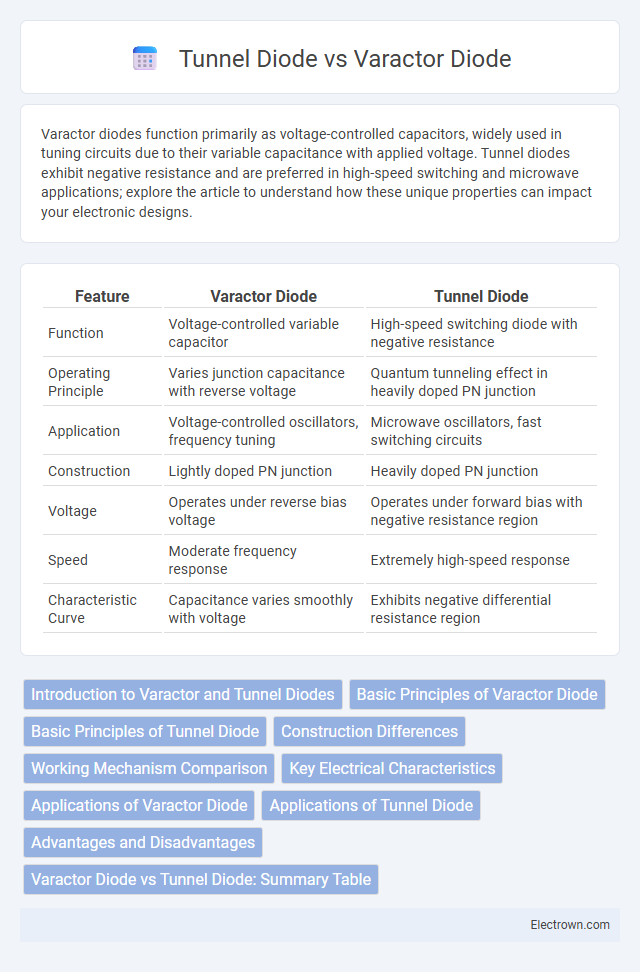Varactor diodes function primarily as voltage-controlled capacitors, widely used in tuning circuits due to their variable capacitance with applied voltage. Tunnel diodes exhibit negative resistance and are preferred in high-speed switching and microwave applications; explore the article to understand how these unique properties can impact your electronic designs.
Table of Comparison
| Feature | Varactor Diode | Tunnel Diode |
|---|---|---|
| Function | Voltage-controlled variable capacitor | High-speed switching diode with negative resistance |
| Operating Principle | Varies junction capacitance with reverse voltage | Quantum tunneling effect in heavily doped PN junction |
| Application | Voltage-controlled oscillators, frequency tuning | Microwave oscillators, fast switching circuits |
| Construction | Lightly doped PN junction | Heavily doped PN junction |
| Voltage | Operates under reverse bias voltage | Operates under forward bias with negative resistance region |
| Speed | Moderate frequency response | Extremely high-speed response |
| Characteristic Curve | Capacitance varies smoothly with voltage | Exhibits negative differential resistance region |
Introduction to Varactor and Tunnel Diodes
Varactor diodes, also known as varicap diodes, function as voltage-controlled capacitors primarily used in tuning circuits, enabling frequency modulation and voltage-controlled oscillators. Tunnel diodes exhibit negative resistance due to quantum tunneling, allowing them to operate at extremely high speeds in microwave and switching applications. Both diodes serve distinct roles in electronic circuits, where varactor diodes optimize frequency control and tunnel diodes enhance high-speed switching performance.
Basic Principles of Varactor Diode
Varactor diodes operate based on the voltage-dependent capacitance of a reverse-biased p-n junction, allowing precise tuning of resonant circuits by varying the applied voltage. Unlike tunnel diodes that utilize quantum tunneling for fast switching in negative resistance regions, varactor diodes function primarily as voltage-controlled capacitors. Your choice of a varactor diode ensures efficient frequency modulation and tuning in RF applications due to its predictable and stable capacitance-voltage relationship.
Basic Principles of Tunnel Diode
Tunnel diodes operate based on quantum mechanical tunneling, where electrons pass through a potential barrier at very high speeds due to heavy doping that creates a narrow depletion region. This results in a negative resistance region in their current-voltage characteristic, enabling applications in high-frequency oscillators and amplifiers. Understanding the basic principles of tunnel diodes is essential for your use in ultra-fast switching and microwave frequency circuits.
Construction Differences
Varactor diodes are constructed with a p-n junction designed to vary its capacitance based on the applied reverse bias voltage, utilizing the width of the depletion region. Tunnel diodes feature a heavily doped p-n junction with an extremely thin depletion layer, enabling quantum tunneling of charge carriers. The construction disparity lies in doping concentration and junction thickness, directly influencing their distinct electronic behaviors and applications.
Working Mechanism Comparison
Varactor diodes operate by varying capacitance through voltage-controlled depletion region width changes, functioning primarily as voltage-controlled capacitors in tuning circuits. Tunnel diodes utilize quantum mechanical tunneling, allowing current to flow through a potential barrier even at low forward bias, characterized by negative resistance useful in high-frequency oscillators. The fundamental distinction lies in varactor diodes' capacitive behavior versus tunnel diodes' tunneling-based conduction mechanism enabling rapid switching and oscillation.
Key Electrical Characteristics
Varactor diodes exhibit voltage-dependent capacitance, making them ideal for frequency tuning and voltage-controlled oscillators, with low leakage current and high Q-factor. Tunnel diodes feature negative resistance due to quantum tunneling, allowing high-speed switching and oscillation at microwave frequencies with low forward voltage drop. Your choice between these diodes depends on whether you need voltage-controlled capacitance or ultra-fast switching capabilities.
Applications of Varactor Diode
Varactor diodes are widely used in RF design for voltage-controlled oscillators (VCOs), frequency modulators, and tunable filters due to their voltage-dependent capacitance. They play a critical role in phase-locked loops (PLLs), enabling precise frequency synthesis in communication systems. Varactor diodes also improve performance in microwave circuits by providing dynamic tuning capabilities essential for adaptive impedance matching and signal modulation.
Applications of Tunnel Diode
Tunnel diodes are predominantly used in high-frequency oscillators and microwave devices due to their negative resistance region enabling rapid switching speeds. Their applications extend to ultra-fast switching circuits, frequency converters, and front-end mixers in radar and communication systems. Compared to varactor diodes, tunnel diodes excel in high-speed digital logic circuits where low power consumption and noise immunity are crucial.
Advantages and Disadvantages
Varactor diodes offer advantages like voltage-controlled capacitance ideal for tuning circuits with low power consumption but suffer from limited frequency range and non-linear capacitance variation. Tunnel diodes provide ultra-fast switching speeds and high-frequency operation due to quantum tunneling effects, yet they face drawbacks such as low output power and operational instability under temperature variations. The choice between varactor and tunnel diodes depends on the required frequency, power handling, and application stability.
Varactor Diode vs Tunnel Diode: Summary Table
Varactor diodes are voltage-controlled capacitors primarily used in tuning circuits, whereas tunnel diodes exhibit negative resistance due to quantum tunneling, ideal for high-speed switching and oscillators. Key parameters include junction capacitance for varactor diodes and peak current with negative resistance region for tunnel diodes, influencing their application in RF design and microwave frequency electronics. Your choice between varactor diode vs tunnel diode should consider operating frequency, tuning range, and non-linear characteristics detailed in the summary table.
varactor diode vs tunnel diode Infographic

 electrown.com
electrown.com